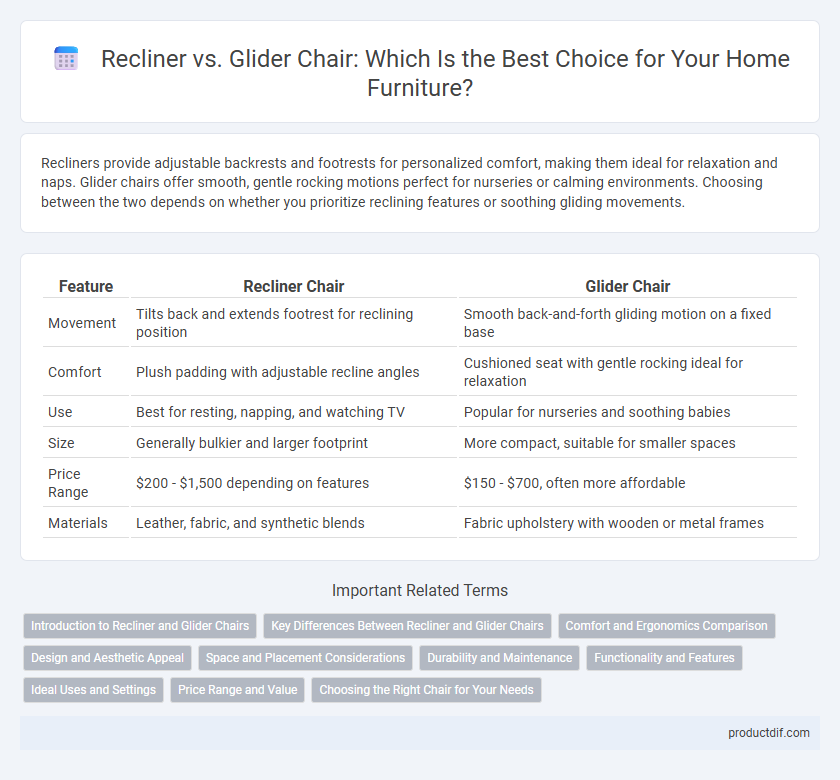Recliners provide adjustable backrests and footrests for personalized comfort, making them ideal for relaxation and naps. Glider chairs offer smooth, gentle rocking motions perfect for nurseries or calming environments. Choosing between the two depends on whether you prioritize reclining features or soothing gliding movements.
Table of Comparison
| Feature | Recliner Chair | Glider Chair |
|---|---|---|
| Movement | Tilts back and extends footrest for reclining position | Smooth back-and-forth gliding motion on a fixed base |
| Comfort | Plush padding with adjustable recline angles | Cushioned seat with gentle rocking ideal for relaxation |
| Use | Best for resting, napping, and watching TV | Popular for nurseries and soothing babies |
| Size | Generally bulkier and larger footprint | More compact, suitable for smaller spaces |
| Price Range | $200 - $1,500 depending on features | $150 - $700, often more affordable |
| Materials | Leather, fabric, and synthetic blends | Fabric upholstery with wooden or metal frames |
Introduction to Recliner and Glider Chairs
Recliner chairs feature adjustable backrests and footrests for personalized comfort, often incorporating power or manual reclining mechanisms. Glider chairs provide smooth, horizontal motion ideal for soothing relaxation, frequently used in nurseries or living rooms. Both furniture types enhance seating comfort but serve different ergonomic and aesthetic purposes.
Key Differences Between Recliner and Glider Chairs
Recliner chairs feature adjustable backrests and footrests for customizable comfort, while glider chairs provide a smooth, horizontal rocking motion ideal for relaxation. Recliners often include manual or power controls for positioning, whereas gliders typically utilize a fixed base with cushioned seating designed for gentle swaying. The primary difference lies in recliners' emphasis on adjustable ergonomics and gliders' focus on soothing movement.
Comfort and Ergonomics Comparison
Recliners provide customizable reclining positions and built-in footrests, offering exceptional lumbar support and pressure relief for extended seating comfort. Glider chairs feature smooth back-and-forth motion with ergonomic cushioning, designed to promote gentle movement and reduce strain on joints, ideal for relaxation and nursing. Both prioritize comfort, but recliners excel in adjustable support, while gliders emphasize rhythmic motion and ergonomic seating.
Design and Aesthetic Appeal
Recliners typically feature a bulkier design with padded armrests and plush cushioning, creating a luxurious and comfortable look ideal for traditional or contemporary living spaces. Glider chairs have a more streamlined, minimalist silhouette with smooth, gliding motion and often come in wood or fabric finishes, blending well with nursery or modern decor styles. Both furniture pieces prioritize comfort, but recliners emphasize relaxation through adjustable reclining positions, while gliders highlight gentle motion and subtle elegance in their aesthetic appeal.
Space and Placement Considerations
Recliners require more floor space due to their extended footrest and reclining back, making them less suitable for small rooms or tight corners. Glider chairs have a compact footprint with a smooth, horizontal gliding motion, allowing easier placement in smaller spaces, such as nurseries or reading nooks. When choosing between the two, prioritize room dimensions and intended use to optimize comfort and functionality.
Durability and Maintenance
Recliners typically feature robust metal frames and high-density foam cushions, offering superior durability compared to glider chairs, which rely on wooden rocking mechanisms that may wear out over time. Maintenance for recliners involves occasional lubrication of metal parts and upholstery cleaning, whereas glider chairs often require tightening of bolts and regular wood polishing to prevent squeaking and wear. Choosing a recliner can reduce long-term upkeep due to its sturdier construction and simpler mechanical components.
Functionality and Features
Recliners offer adjustable backrests and footrests, providing customizable comfort and support for prolonged sitting or napping. Glider chairs feature a smooth, back-and-forth motion ideal for soothing relaxation, especially popular for nurseries due to their gentle rocking capabilities. Both options prioritize ergonomic design but differ in movement mechanics and intended use, with recliners emphasizing versatility and gliders enhancing calming motion.
Ideal Uses and Settings
Recliners offer adjustable comfort ideal for living rooms and home theaters, providing support for extended relaxation or napping. Glider chairs excel in nurseries and small spaces, offering smooth, gentle rocking motions perfect for soothing infants. Choosing between a recliner and a glider depends on space availability and primary use, with recliners suited for personalized comfort and gliders for calming environments.
Price Range and Value
Recliners generally fall within a price range of $200 to $1,500, offering adjustable comfort and ergonomic support that enhances value for money. Glider chairs, typically priced between $150 and $700, provide smooth rocking motion and compact design ideal for smaller spaces, maximizing affordability and functionality. Both furniture types deliver specific benefits, so choosing between a recliner and glider chair depends on budget constraints and preferred seating features.
Choosing the Right Chair for Your Needs
Recliners offer adjustable reclining positions and built-in footrests ideal for maximum relaxation, making them perfect for watching TV or napping. Glider chairs provide smooth, back-and-forth motion with a stable base, often preferred in nurseries for soothing babies. Assess your primary use, space constraints, and ergonomic preferences to select between the reclining comfort of recliners and the gentle motion of gliders.
Recliner vs Glider Chair Infographic

 productdif.com
productdif.com